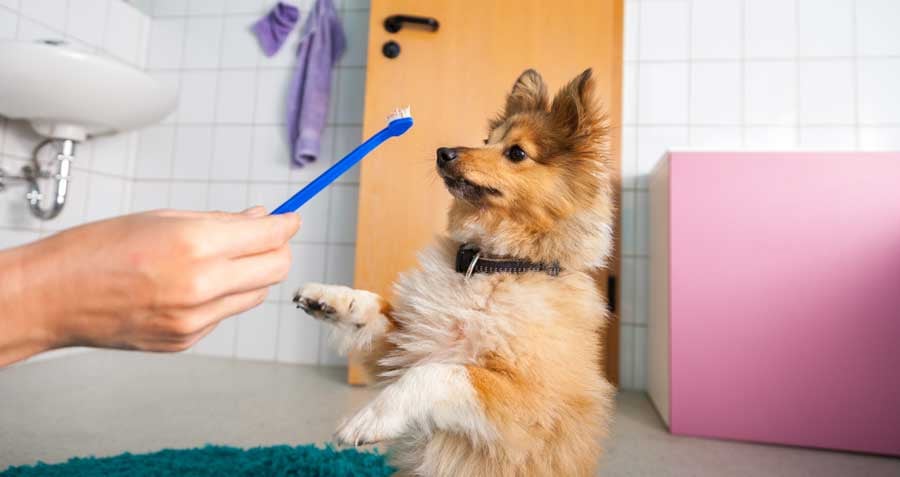Do you have two minutes—or even less—to take out of every day for your dog's health? Of course, you do. Every responsible pet owner spends more than that every day tending to his or her dog's needs, whether it's through daily walking, feeding, or attention. But even the best-intentioned dog owners can still neglect one important part of their pet's care: teeth brushing. You may be avoiding brushing your dog's teeth because you fear it'll be complicated, difficult, or time-consuming. With a little practice and some training, brushing your dog's teeth can be easy and straightforward. Use this overview to guide you toward a healthy dental hygiene routine for your canine companion.
Your Guide to Canine Dental Hygiene
The first step in developing a tooth brushing routine with your dog is to set your expectations realistically. It's easy to expect immediate results when training your dog to accept tooth brushing, but it won't happen right away. In fact, if you experience resistance, you should step back and try again tomorrow. Resistance is a sure sign that you're moving too fast and that your dog needs more time to grow accustomed to dental hygiene.
Here are the hallmarks of a good tooth-brushing training routine:
- Make it pleasant: Your dog should look forward to when you brush his or her teeth because you'll be giving attention, love, and treats.
- Make it consistent: With consistency, your dog should begin to understand that it won't hurt to have her teeth brushed and that it won't take long.
- Make it a part of your daily routine: While you're training, you should brush your dog's teeth a few times a day—maybe once before you leave for work, once when you get home, and once again before bed. This helps make training faster. Once your dog is trained, you can move to brushing only once a day.
- Be patient: As mentioned above, don't rush this process. Depending on your dog's temperament, this training could take anywhere from a week to several months.
Now that you've set your expectations and know what you're getting into, here are the nitty-gritty details of how to brush your dog's teeth.
Brushing Your Dog's Teeth
You'll need:
- Pet toothpaste: You can purchase dog toothpaste from a local pet supply store or your veterinarian. Never use human toothpaste on your dog—its fluoride content could be harmful!
- Your dog's favorite treat: Whether bacon or a dog snack, choose something you know your pup will be motivated by.
- A finger brush: Many pet owners prefer a finger brush. However, you can experiment with all kinds of toothbrushes to find what you and your dog prefer. Just be sure you don't choose something with harsh bristles that could damage your dog's gums.
And now, you're ready to get started!
Instructions:
- Get your dog acclimated: When training, you want to get one message through to your dog: toothbrush = treats. This positive association will make tooth brushing a breeze in the future. Begin by having your dog sit still for a few seconds, then giving her a treat. Then raise her gums on the left side and give her another treat. Then rub your dog's gums with your fingers, and—you guessed it—give her another treat. Move slowly like this until your dog begins to pull away or seems nervous. Don't start to use the toothbrush just yet—just have it nearby. At the first signs of pulling away, give it a rest and try again later.
- "Brush" with your finger: For the first few full brushings, use only your finger with toothpaste on it.
- Introduce the toothbrush: A good way to show your dog the toothbrush for the first time is by letting him lick some of the toothpaste off of it. When you feel that your dog is comfortable with you using your finger and toothpaste, add the brush. Focus always on the top teeth first—these are the easiest to get to and should be the only teeth touched during your training periods. Gently lift your dog's gums with your free hand and use your dominant hand to brush down and away from your dog's gums.
- Incorporate the whole mouth: Once you feel that your dog is comfortable with the toothbrush and having all of her upper teeth brushed, move on to the more difficult lower teeth. These may take longer for both of you to master and grow comfortable with, so again, be sure not to move too quickly. Use treats liberally during this training process.
- Brush daily: Once you've trained your dog to accept brushing, be sure to keep up the habit by regular brushing, followed by a treat.
If you're nervous about beginning the tooth brushing process with your dog, or if it's been a while since your dog's last teeth cleaning, it's a good idea to schedule a dental checkup for your dog. Contact us if for more information about dog dental exams.

